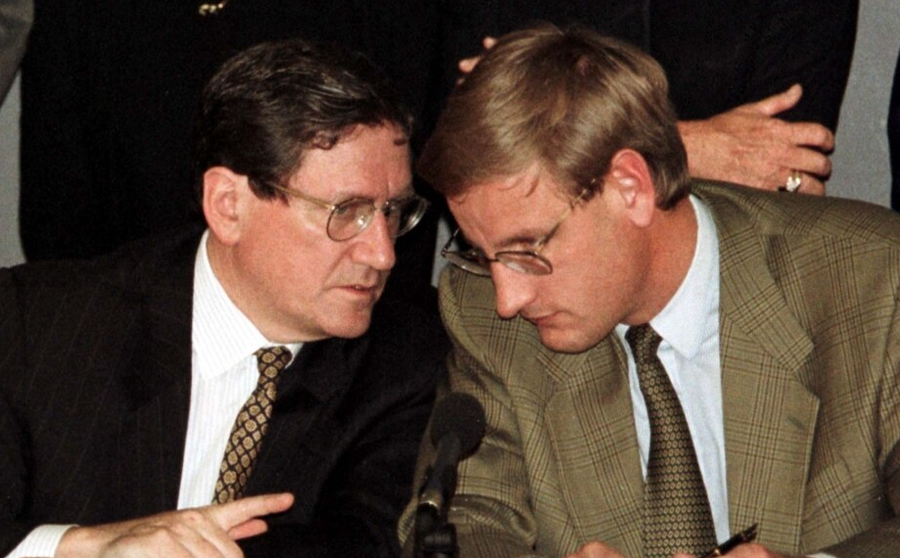
With the presence of Russian and Ukrainian delegations last week in Riyadh, diplomatic efforts to end the conflict in Ukraine entered a new phase.
However, they did not meet in person.
American negotiators used so-called "flying diplomacy," holding separate meetings, sometimes with one side and sometimes with the other.
According to diplomats, this is a strategy remarkably similar to the negotiations that brought an end to the war in Bosnia 30 years ago.
The Dayton Peace Accords, finalized in November 1995 at Wright-Patterson Air Force Base in Dayton, Ohio, were the result of American high-flying diplomacy with Bosnian, Serbian, and Croatian leaders.
How did flying diplomacy work?
The meetings in the Saudi capital, from March 23 to 25, to end the war in Ukraine, which has now entered its fourth year, somewhat resemble the events surrounding Dayton, says Christopher Hill, former US ambassador to Serbia and North Macedonia.
As deputy to the chief American negotiator and "architect" of the Dayton Accords, Richard Holbrooke, Hill was closely involved in the peace process.
"We noticed that when they got together, they would just give speeches about their disagreements, why they were right and the other side was wrong... So we saw flying diplomacy as a much more effective tool," says Hill.
In an effort to achieve peace, American diplomats held meetings in Belgrade, Zagreb, and Sarajevo, as well as in Geneva.
The goal, Hill recalls, was to create an idea of what all parties wanted.
“And then, eventually, towards the end of the Dayton [process], we started bringing them together in the same room,” says Hill.
This method, according to him, has been used many times by Henry Kissinger, the US Secretary of State under President Richard Nixon, as well as by Middle East negotiators.
"But I think it was quite successful in Bosnia," he adds.
The Dayton Accords were signed in Paris on December 14, 1995, and marked the end of a conflict that left over 100,000 people killed, two million displaced, and extensive destruction.
Mate Granic, who was deputy chief negotiator for Croatian President Franjo Tudjman during the Dayton era, says that flying diplomacy is useful when positions are far apart.
"Ukraine wants a just peace, while Russia has made it clear that it does not even want to discuss the occupied territories. Moscow also refuses to allow NATO peacekeeping forces or further military assistance to Ukraine," Granic says.
"Given this, flying diplomacy is the logical starting point," he emphasizes.
Nebojsa Vujovic, a member of the delegation led by Serbian leader Slobodan Milosevic to the Dayton process, says that current US tactics with Ukraine and Russia could bring them closer - just as Richard Holbrooke managed to do in the 1990s.
"The fact that [US President Donald] Trump and [Russian President Vladimir] Putin are speaking on the phone, as is Trump with [Ukrainian President Volodymyr] Zelensky, while the US envoy visits Kiev and Moscow and reports to Trump, means that the flying diplomacy is currently bringing things to a point where an initial ceasefire agreement can emerge," Vujovic said.
After the conclusion of talks in Riyadh last week, the United States announced the achievement of separate agreements with Russia and Ukraine regarding efforts to stop attacks on energy facilities in both countries and to stop the use of force in the Black Sea.
Lessons from Dayton
Holbrooke once called Dayton an "imperfect peace."
The agreements created two entities - Republika Srpska and the Federation of Bosnia and Herzegovina; three constituent peoples; one district; ten cantons and a three-member presidency.
Despite efforts in 2006 and 2009 to change them, there has been no substantial change.
Reflecting on the Dayton process three decades later and on the lessons learned for future negotiations, including those between Ukraine and Russia, Hill says continued engagement is important.
"I think that's going to be necessary. You can't just say, 'Well, that problem is over. Let's move on to the next one,'" Hill says.
But could there be a meeting between Putin and Zelensky in the future? Hill thinks that's unlikely.
"I think Putin has assured us that there will be hostility between Ukraine and Russia for many generations. So I wouldn't try to bring them together..." he says.
While Bosnia remains burdened by divisions and dysfunction, it spent nearly three decades at peace, making Dayton one of the most successful peace agreements in modern history.
Granic says that the key to Dayton's success was a compromise with very strong foundations.
"But, of course, further work and negotiations are [still] necessary," he adds.
Former Serbian diplomat Vujovic agrees.
"It built a peace that lasted for almost 30 years. Dayton... prevented destruction and loss of life and, at the same time, created two entities that remained stable, enabling a form of coexistence," he says.
While the 1995 agreements had their flaws, Hill emphasizes that the United States did not impose anything on anyone.
"We were intermediaries," he says.
"We were trying to achieve things that both parties - actually, all three parties - could live with. That was hard to do," Hill recalls.
Ultimately, wars end, he adds, and when you look at how they end, diplomacy usually plays a role.
"How big a role it is remains to be seen. I think it makes sense to end this war. You know Ukraine has been destroyed, but I think, in many ways, Russia has suffered profound damage, not just from the drones, but also in terms of how it is perceived in the world," Hill says.
"I don't think anyone will look at the Russians the same way. It has to end. But how it will end is hard to say," he emphasizes./ REL (A2 Televizion)











